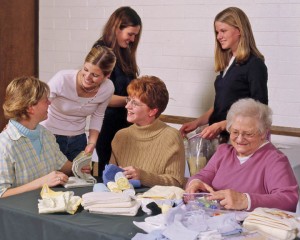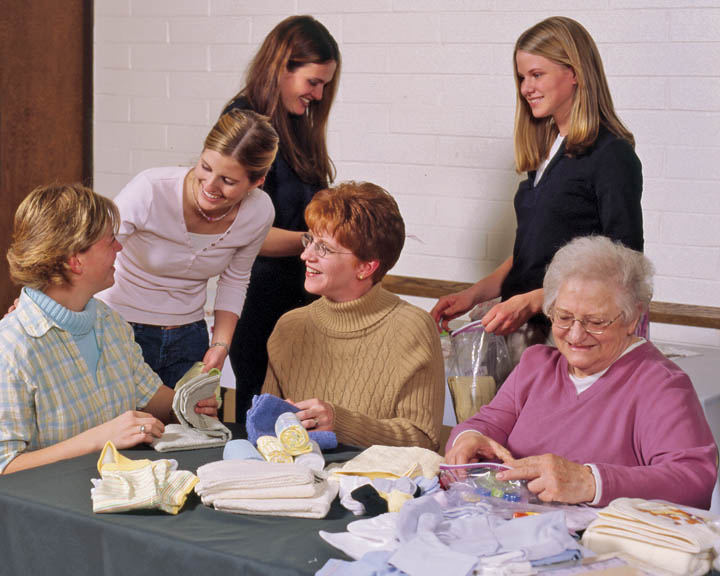There are three different meetings that members of the Church of Jesus Christ of Latter-day Saints participate in during regular Sabbath observance. Sacrament Meeting is the most important meeting of all and is where we partake of the emblems of the body and blood of Christ and renew our covenants with Him. Sacrament Meeting usually lasts for 70 minutes. But there are other meetings that happen before or after Sacrament Meeting (depending on the ward and building scheduling times). Relief Society is one of these meetings.
 What exactly is Relief Society ?
What exactly is Relief Society ?
The Relief Society was founded by the Prophet Joseph Smith on March 17, 1842, in Nauvoo, Illinois. In the days of its founding, it had two main purposes: to provide relief for the poor and needy and to bring people to Christ. The organization continues today, staying true to those original guiding principles as women in the Relief Society meet together on Sunday and in other settings as needed.
Over the years, this great society for women has evolved under inspiration, but the basic work of the Relief Society has not changed. The Prophet Joseph stated very succinctly that your work is “not only to relieve the poor, but to save souls.”
I believe the four great enduring concepts of this society are:
First, it is a divinely established sisterhood.
Second, it is a place of learning.
Third, it is an organization whose basic charter is to serve others. Its motto is “Charity never faileth.”
Fourth, it is a place where women can socialize and establish eternal friendships
What happens in a Relief Society meeting? Typically, when you walk into a Relief Society meeting, you will find that the Relief Society presidency (the president, her two counselors and a secretary) is setting up the room while a pianist plays soft prelude music. As you find a seat, you may strike up a quiet conversation with the woman next to you as you ask her how her week was. Or you might listen as the sister in front of you describes the reception at her daughter’s wedding. Or you might watch the baby roll on the floor across the aisle from you. Or it might be a time of quiet meditation where you ponder the atonement of Christ or pray for the desires of your heart.
When it is time for the meeting to begin, one member of the presidency will conduct while the remainder of the presidency sit near the front of the room. The woman conducting will welcome the sisters and may ask for people she doesn’t recognize to introduce themselves. Then the meeting will begin with an opening hymn. This song is usually played on the piano and the congregation is expected to sing from the hymnbook while the chorister leads the music at the front of the room. After the hymn, a sister, who was previously asked, will stand to give the opening prayer.
When she is through praying, the sister conducting the meeting will stand again and tell the sisters of any announcements. Perhaps Sister Johnson is in the hospital undergoing surgery. There is a ward party that Friday. Don’t forget the book club meeting Wednesday night. Sometimes there may be a “musical spotlight”—a brief moment when the chorister discusses how we came to have a favorite hymn, or to sing another song, or to hear a soloist. Some wards have other fun tidbits, like a “good news minute” where the sisters have an opportunity to share their good news from that week. Sister Ruiz just found out she is pregnant. Sister Murray’s husband got a new job. Sister Lee’s son made the honor roll for the first time. Sister Anton’s daughter finally moved out of the house! Or they might recognize those women who have a birthday coming up this next week.
During this time, roll is taken. I have been in wards where the secretary just marks the person there. But usually, it has been a folder or clipboard passed around at the beginning of the meeting where the sisters mark or sign their name. There may also be other sign-ups. Because Sister Johnson is in the hospital, her family will need meals brought in for the next few days—can you help?
When the announcements are done, it’s time for the lesson. There are usually a few different women who have been called to teach Relief Society. They switch off every few weeks. So the woman who is teaching today may not be teaching again for a month. On the first Sunday of the month, the lesson is given by a member of the Relief Society presidency and is a topic that she picks as being especially pertinent to the sisters in this ward, at this time. On the fourth Sunday of the month, the lesson is a “Teachings for Our Times” lesson. These lessons are picked by the Stake President from the addresses given in the last General Conference. But this is a second Sunday, so the teacher’s lesson is based on the world-wide church curriculum. This year, we are studying the teachings of the prophet Spencer W. Kimball. In 2008, we will study teachings of the prophet Joseph Smith.
The teacher will have prepared and prayed about her presentation. She has read the manual and additional scriptural resources. She has points that she wants to make that she feels are important but she will also want to involve the sisters in the room because they also have a wealth of experiences and insights. So questions are asked and discussions are encouraged, too. The teacher usually stands at the front of the room and may use a chalkboard, a dry-erase board, or other visual aids to help with her lesson.
When she is finished with the lesson, the sister conducting the meeting will stand again and close the meeting*. There will be a closing hymn in the same manner as the opening hymn and a different sister will give the closing prayer. There may be a little more socializing and talking, but usually there is another ward’s Relief Society who will need to use the room next and so the sisters leave the next Relief Society presidency to set up the room.
*The first Sunday of the month is Fast Sunday. If this Relief Society meeting had taken place on the first Sunday of the month, the lesson would be shorter and there would be time left at the end of the lesson for the sisters to bear their testimonies to each other before the closing


